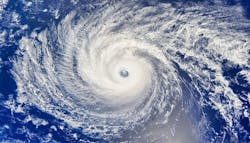Supply chain resilience in the age of climate change
It’s that time of year again. The Atlantic hurricane season, which runs from June 1 to November 30, was predicted to be one of the busiest in years. So far, even with nearly 100 deaths and 9 billion dollars in damage, mostly from Hurricanes Beryl and Debby, this hurricane season seems “unusually mild.” Experts, however, expect Atlantic storm activity to pick up soon. This is an opportunity for the pharmaceutical industry to enjoy the calm while planning for the task of ensuring the resilience of their supply chains in the face of climate change.
Consider Hurricane Maria, which devastated Puerto Rico in 2017. What happened to the U.S. medical supply chain in the aftermath is a stark reminder of the vulnerabilities of concentrating pharmaceutical production in a single location. The lessons of Hurricane Maria should not be forgotten.
Puerto Rico is a top pharmaceutical hub. It is home to 12 of the world’s top 20 pharmaceutical companies and supplies half of the top ten best-selling drugs. As the push for pharmaceutical reshoring grows in light of the COVID-19 pandemic and geopolitical tensions, Puerto Rico is expected to become increasingly important as a U.S. territory.
Nonetheless, climate change has emerged as a complicating factor that one cannot simply look away from. Hurricane Maria caused severe infrastructure damage, resulting in significant production delays as companies struggled with power outages and communications failures. Despite heroic efforts by companies, local communities, and governments to maintain operations, the hurricane caused immediate shortages of medical supplies, such as IV fluids, across the U.S., forcing hospitals to implement workarounds, ration supplies, and resort to costly alternatives.
One of the key lessons learned from Hurricane Maria is the need to diversify manufacturing locations. Companies that spread their operations across multiple geographic areas are better positioned to mitigate the risk of widespread disruption. Relying on a single location, whether domestic or international, is a weakness that can also prove costly.
In other words, while the notion of reshoring — bringing manufacturing back home — has been hailed as a solution to improving supply chain resilience, it is not a panacea by itself. The focus should be not only on bringing production back home, but also on ensuring that it is diversified across multiple locations in the U.S. and around the world to avoid new concentrations of risk. A robust supply chain de-risking strategy should include a portfolio of reshoring, near-shoring, and friend-shoring. This portfolio approach spreads risk and ensures that disruptions in one location do not cripple the entire system.
Diversification requires assessment of climate risks in different locations, such as hurricanes, heat waves, and floods. A recent study published in the Review of Financial Studies shows that companies are 7% more likely to cut ties with suppliers when climate risks in their locations exceed expectations. In other words, companies are already selecting manufacturing locations with lower climate risk profiles, just as supply chain resilience becomes a top concern for C-suite executives.
In addition to diversification, strengthening infrastructure is critical. The devastation of Puerto Rico’s power grid during Maria underscored the importance of backup systems and hardened facilities.
Companies have since made significant investments in these areas, recognizing that resilient infrastructure is critical to maintaining operations during and after a storm.
But restoring supply chains to pre-disaster levels is no longer enough. As climate change intensifies, the risk of concentrating a supply base in one location — domestic or foreign — becomes increasingly unsustainable. Relying on one location, whether it is Puerto Rico or certain regions of Asia or Europe, increases the risk of severe disruptions from natural hazards. Therefore, the pharmaceutical sector must prioritize transformation over recovery — rebuilding with resilience and adaptability in mind.
Effective coordination with government agencies is another critical technique for increasing supply chain resilience. The post-Maria recovery efforts demonstrated the value of this collaboration, which can expedite regulatory processes and enable the rapid import of critical goods during a crisis.
Workforce support is also critical. After Maria, many employees in Puerto Rico were unable to return to work due to personal losses and ongoing infrastructure challenges. Companies need to ensure that their natural hazard preparedness strategies include measures to support employees, such as emergency financial assistance and flexible work arrangements.
As the pharma industry grapples with an increasingly volatile climate, the lessons learned from Hurricane Maria provide an important blueprint for future resilience. To manage escalating risks, the industry must prioritize diversification, strengthen infrastructure, and cultivate strong partnerships. These strategies are not just about weathering the next storm; they are about ensuring the uninterrupted flow of life-saving medical supplies. After all, this is an industry where building a resilient supply chain is not an option — it’s an imperative.
About the Author
Tinglong Dai
Bernard T. Ferrari Professor, Johns Hopkins University Carey Business School
Tinglong Dai is a Professor of Operations Management and Business Analytics at the Carey Business School, Johns Hopkins University, with expertise in the areas of healthcare analytics, global supply chains, the interfaces between marketing and operations, and human–AI interaction.
